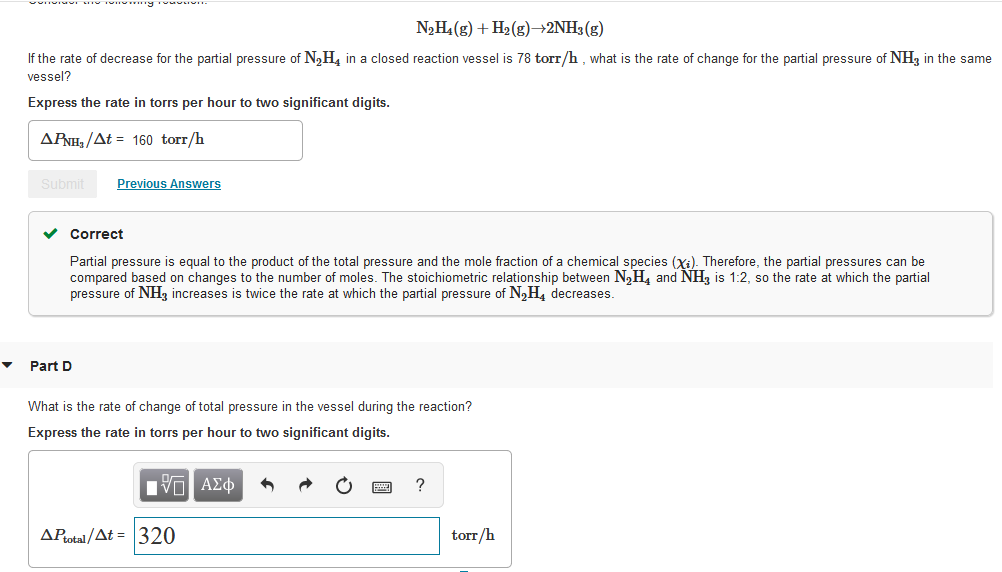N2H4(g) + H2(g)–→2NH3(g) If the rate of decrease for the partial pressure of N,H, in a closed reaction vessel is 78 torr/h , what is the rate of change for the partial pressure of NH3 in the same vessel? Express the rate in torrs per hour to two significant digits. APNH /At = 160 torr/h Submit Previous Answers Correct Partial pressure is equal to the product of the total pressure and the mole fraction of a chemical species (Xi). Therefore, the partial pressures can be compared based on changes to the number of moles. The stoichiometric relationship between N,H, and NH3 is 1:2, so the rate at which the partial pressure of NHz increases is twice the rate at which the partial pressure of N2H, decreases. Part D What is the rate of change of total pressure in the vessel during the reaction? Express the rate in torrs per hour to two significant digits. AProtal/At = 320 torr/h
Lipids
The heterogeneous classes of organic compounds that are not water-soluble but are dissolved in organic solvents that are non-polar in nature are termed lipids. They are a long chain of fatty acids and esters of alcohols. Lipids are generally seen in several plants, microorganisms, and animals. They are utilized as insulation, components of the cell membrane, hormones, and molecules for the storage of energy.
Glycerophospholipid
Glycerophospholipid is the most abundantly occuring phospholipids found in the biological membranes. Lipids include a group of organic compounds like fats, hormones, oils, waxes, vitamins etc. They are non-polar molecules and are insoluble in water. Lipids play an important role in biological systems. They are the building blocks of our cell membranes, store energy and are involved in signaling.
Structure Of Camphor
A terpene with the molecular formula of C10H16O is a waxy, white color solid known as camphor. It is flammable. It also possesses a very pungent taste and a strong odor. There are various sources for extracting camphor from natural products such as the wood of the tree of camphor laurel. Sublimation of wood and steam distillation are some of the methods involved in obtaining camphor.
Glycolipid In Organic Chemistry
Glycolipids are lipids that are an important class of organic compounds in chemistry that have simple to complex applications. They contain carbohydrates, fatty acids, sphingolipids or a glycerol group. In other words, they are the modifications of lipids like acylglycerols, prenols and ceramides. They are all part of a wider group of compounds known as glycoconjugates.
Diterpenoid
The terpenoid class includes diterpenoids, which are chemical compounds with 20 carbon atoms. They are made up of four isoprene units and are derived from geranylgeraniol, a C20 precursor. They have a C20H32 basic structure. These characteristics distinguish diterpenoids from simple terpenes, which have just 10 carbon atoms.
Please part D, I already complete a, b, c

![Consider the combustion of ethylene:
C2H (g) + 302(g)→2CO2(g) + 2H20(g)
If the concentration of C2H4 is decreasing at the rate of 3.8x10-2 M/s , what is the rate of change in the concentration of CO2?
Express the rate in molarity per second to two significant digits.
A[CO2]/At = 7.6×10-2 M/s
Submit
Previous Answers
v Correct
The stoichiometric relationship between C2H4 and CO2 is 1:2, so the rate at which the concentration of CO2 increases is twice the rate at which C2H
decreases.
Part B
What is the rate of change in the concentration of H,O?
Express the rate in molarity per second to two significant digits.
A[H2O]/At = 7.6×10-2 M/s
P Pearson](/v2/_next/image?url=https%3A%2F%2Fcontent.bartleby.com%2Fqna-images%2Fquestion%2F97c4b753-4d37-4f67-8dde-749f0b47db81%2Fbcec1d10-3796-4d44-a580-3c7c3c7dcf45%2Fjneqhb_processed.png&w=3840&q=75)
Given:
Trending now
This is a popular solution!
Step by step
Solved in 4 steps









